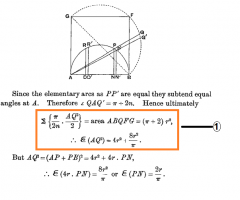Win_odd Dhamnekar
Junior Member
- Joined
- Aug 14, 2018
- Messages
- 207
Show that
(1)if from a random point on the diameter of a semicircle a perpendicular be erected to meet the arc, its average length will be π ÷ r of the radius.
(2)But if from a random point on the arc , a perpendicular be let fall on the diameter , its average length will be 2 ÷ π of the radius.
I computed the answer to (1) but I don't know how did author compute the answer 2 ÷ π to question (2)?
Any math help will be accepted.
(1)if from a random point on the diameter of a semicircle a perpendicular be erected to meet the arc, its average length will be π ÷ r of the radius.
(2)But if from a random point on the arc , a perpendicular be let fall on the diameter , its average length will be 2 ÷ π of the radius.
I computed the answer to (1) but I don't know how did author compute the answer 2 ÷ π to question (2)?
Any math help will be accepted.



